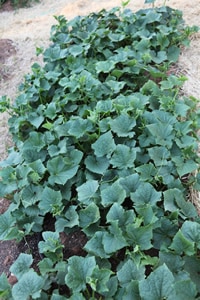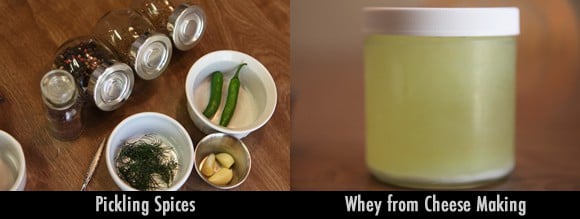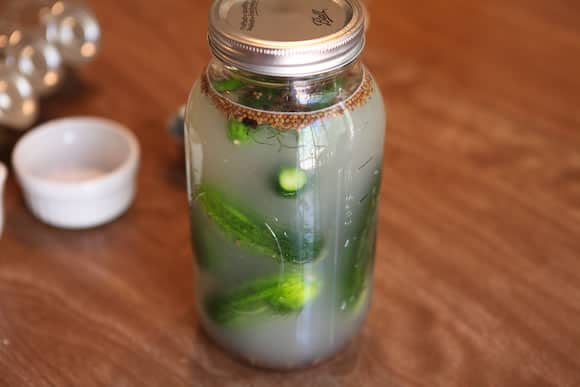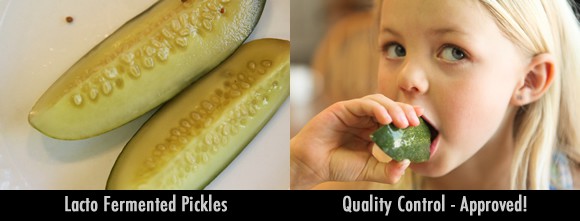 This is a super easy and nutritious alternative to the vinegar, water-bath canning method of pickling cucumbers. It utilizes fresh cucumbers as they become available in your garden. This method is quick enough to make that during the peak of cucumber production, we make a small batch of pickles every day or so. The results are a tasty probiotic treat.
This is a super easy and nutritious alternative to the vinegar, water-bath canning method of pickling cucumbers. It utilizes fresh cucumbers as they become available in your garden. This method is quick enough to make that during the peak of cucumber production, we make a small batch of pickles every day or so. The results are a tasty probiotic treat.
If you aren’t familiar with lacto-fermentation, it is the process that produces traditional dill pickles, sauerkraut, and other traditional fermented foods. It takes only salt, vegetables, and water, and there are no canners or fancy equipment required. The idea is simple: the salt and whey (optional; used as a starter) kill any “bad” bacteria while allowing “good,” healthy bacteria to flourish. The good bacteria, mainly Lactobacillus, convert lactose and other sugars present in the vegetables (in this case, cucumbers) into lactic acid. The resulting acidic environment safely preserves the cucumbers and gives them their characteristic tangy flavor.
Below is a basic recipe to get you started.
Equipment and Ingredients:
- 1 quart-sized mason jar
- 4-6 medium cucumbers, or enough to fill your jars
- 1-2 Tablespoons fresh dill
- 1 Tablespoon sea salt
- 4 Tablespoons whey (or additional 1 Tablespoon sea salt)
- 1 Tablespoon mustard seed
- Other spices of your choice (optional – we like coriander, cumin, peppercorns)
- Peeled garlic cloves (optional, 1-3 per jar)
- Peppers (optional, 1-2 per jar)
- Filtered water

Method:
1. Ice bath
Harvest your cucumbers, clean them with fresh cool water, and let them sit in a cold ice bath for 3-4 hours. This step is optional, but will produce a crispier pickle.

2. Sterilize
Clean and sterilize all of your equipment. These pickles will be fermented at room temperature, so everything that will come into contact with your cucumbers, including the knife, the measuring spoons, and the mason jars, should be sterilized. We run our equipment through a hot cycle in our dishwasher.
3. Pack your jars
Pack your mason jars with spices, garlic, peppers, and dill. For every quart jar, we use 1 serrano pepper, 2 peeled garlic cloves, 1 Tbsp. mustard seed, 1 tsp. coriander, and 1 Tbsp. mixed peppercorns. Add 1 Tbsp. sea salt, and 4 Tbsp. whey (or additional 1 Tbsp. sea salt). Pack your cucumbers in tight, and fill with filtered water. The water must be enough to cover your cucumbers, but you also want about 1 inch headspace to allow space for gases that will be released during fermentation. If the cucumbers float, you can optionally stuff a sealed plastic bag filled with water into your jar to help keep everything submerged. Seal the jars tightly.

4. Allow to rest
Let your jars rest at room temperature for 3-7 days, depending on taste. We like ours after 3 or 4.

5. Store and enjoy
Store your jars in the refrigerator. From what we have read, they should easily store 4 months, some sources even say 6 months. They don’t last that long around here!

We hope this gives you some good inspiration to try this method of making pickles and other fermented foods. We welcome your comments and invite you to share your experiences and recipes for this type of healthful food.
~ Three Meals Farm
Resources
- Lactic Acid Fermentation
- Health Benefits - realpickles.com
- Wild Fermentation: The Flavor, Nutrition, and Craft of Live-Culture Foods
- Nourishing Traditions
This is a companion discussion topic for the original entry at https://peakprosperity.com/how-to-make-lacto-fermented-pickles/